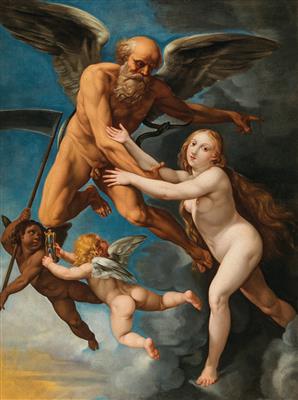Giuseppe Cesari, called Cavaliere d’Arpino

(Arpino 1568–1640 Rome)
Time abducting truth,
oil on canvas, 120.5 x 91 cm, framed
Provenance:
art market, France;
where acquired by the present owner
We are grateful to Herwarth Röttgen for confirming the attribution of the present painting. According to Röttgen the present composition by Cavaliere d’Arpino, is a typical example of the artist’s late style and can be dated to around 1630.
The stylised composition incorporates figures with clear but soft contours before an atmospheric, greyish-blue sky. The female figure in the present painting can be compared to another painting by Cesari, Santa Cecilia con un’altra santa ed un putto, which is in a private collection (see H. Röttgen, Il Cavalier Giuseppe Cesari d’Arpino. Un grande pittore nello splendore della fama e nell’incostanza della fortuna, Rome 2002, p. 455, no. 231a).
The present composition shows the Allegory of Truth fleeing into the arms of her father, the personification of Time, characterised by his attributes of the sickle and the hourglass. The pale-skinned female with her gold, flowing hair acts as a counterpart to the darker complexion of the winged incarnation of Time. Such differences are reinforced further by the palette of their respective backdrops: the elegant depiction of Truth seems to radiate as she steps out of dark clouds, whereas the muscled figure of the male nude is set against the azure sky.
It is not known who commissioned the present painting and any documentation surrounding its conception remains obscure. Comparative analysis, however, locates the present painting to another of the same subject, though compositionally different, in the Colonna Collection in Rome, which was executed around 1622-1627 (see H. Röttgen, Ibid., 2002, p. 432, no. 197). The title of the Colonna painting was renamed by Röttgen from Il tempo che rapisce la bellezza (Time abducting beauty), as it was known in the inventory, to Verità figlia del tempo salvato ed elevato al cielo (Truth daughter of time saved and elevated to heaven) implying that truth always comes to light over time.
Cavaliere d’Arpino was one of the most important painters in Rome between 1592 and 1610, receiving several significant commissions during this time. Over and above being a teacher to the young Caravaggio for eight months, his influence on late Mannerism and early Roman Baroque cannot be underestimated.
Specialist: Mark MacDonnell
 Mark MacDonnell
Mark MacDonnell
+43 1 515 60 403
mark.macdonnell@dorotheum.at
08.06.2021 - 16:00
- Realized price: **
-
EUR 37,800.-
- Estimate:
-
EUR 30,000.- to EUR 40,000.-
Giuseppe Cesari, called Cavaliere d’Arpino
(Arpino 1568–1640 Rome)
Time abducting truth,
oil on canvas, 120.5 x 91 cm, framed
Provenance:
art market, France;
where acquired by the present owner
We are grateful to Herwarth Röttgen for confirming the attribution of the present painting. According to Röttgen the present composition by Cavaliere d’Arpino, is a typical example of the artist’s late style and can be dated to around 1630.
The stylised composition incorporates figures with clear but soft contours before an atmospheric, greyish-blue sky. The female figure in the present painting can be compared to another painting by Cesari, Santa Cecilia con un’altra santa ed un putto, which is in a private collection (see H. Röttgen, Il Cavalier Giuseppe Cesari d’Arpino. Un grande pittore nello splendore della fama e nell’incostanza della fortuna, Rome 2002, p. 455, no. 231a).
The present composition shows the Allegory of Truth fleeing into the arms of her father, the personification of Time, characterised by his attributes of the sickle and the hourglass. The pale-skinned female with her gold, flowing hair acts as a counterpart to the darker complexion of the winged incarnation of Time. Such differences are reinforced further by the palette of their respective backdrops: the elegant depiction of Truth seems to radiate as she steps out of dark clouds, whereas the muscled figure of the male nude is set against the azure sky.
It is not known who commissioned the present painting and any documentation surrounding its conception remains obscure. Comparative analysis, however, locates the present painting to another of the same subject, though compositionally different, in the Colonna Collection in Rome, which was executed around 1622-1627 (see H. Röttgen, Ibid., 2002, p. 432, no. 197). The title of the Colonna painting was renamed by Röttgen from Il tempo che rapisce la bellezza (Time abducting beauty), as it was known in the inventory, to Verità figlia del tempo salvato ed elevato al cielo (Truth daughter of time saved and elevated to heaven) implying that truth always comes to light over time.
Cavaliere d’Arpino was one of the most important painters in Rome between 1592 and 1610, receiving several significant commissions during this time. Over and above being a teacher to the young Caravaggio for eight months, his influence on late Mannerism and early Roman Baroque cannot be underestimated.
Specialist: Mark MacDonnell
 Mark MacDonnell
Mark MacDonnell
+43 1 515 60 403
mark.macdonnell@dorotheum.at
|
Buyers hotline
Mon.-Fri.: 10.00am - 5.00pm
old.masters@dorotheum.at +43 1 515 60 403 |
| Auction: | Old Master Paintings I |
| Auction type: | Saleroom auction with Live Bidding |
| Date: | 08.06.2021 - 16:00 |
| Location: | Vienna | Palais Dorotheum |
| Exhibition: | 29.05. - 08.06.2021 |
** Purchase price incl. charges and taxes
It is not possible to turn in online buying orders anymore. The auction is in preparation or has been executed already.
